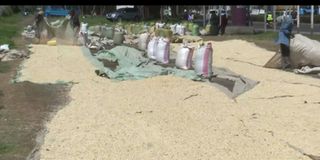Why the railway grounds become a maize drying site in Nakuru

Maize being sun dried at Railway grounds in Nakuru.
If you are new to Nakuru, you may have wondered why there is always maize laid out in the sun to dry as you walk along the railway grounds near the KFA building.
This is done regardless of the time of year, with the month of August being the time when the amount of maize to be dried is high.
Drying maize by spreading it out on polythene sheets in the open under the sun is an age-old tradition practised by farmers.
This phenomenon is usually observed after the planting season. A farmer would dry the harvested maize outside the compound of his home and later store for either domestic use or for commercial purposes.
In Nakuru, however, the practice takes place in the heart of the city. At the railway grounds, men can be seen carrying 90kg bags of maize to the drying area and later transporting them back to storage.
This activity is particularly common, with traders using the space to dry grain for sale, employing many people.
Kenneth Daniel has been working as a casual labourer drying grain for the past 15 years, a job he took up after moving to Nakuru in search of work.

Kennedy Daniel (left) and his colleague Bernard Ajeje.
"When I arrived in Nakuru, I tried to find a job but my efforts were unsuccessful. When I inquired about a job at the railway station, I was hired almost immediately and that's how I started," says Daniel.
His job is to unload the grain and spread it out on the polythene sheets on the ground.
Occasionally he has to shuffle the maize to ensure that all the grains are exposed to the sun. Finally, he then loads the dried grains into bags for storage or sale.
His day usually starts at 8am, although the starting time can vary depending on the amount of maize that needs to be dried.

Packed dried maize in the store.
"Sometimes I have to come in early and stay late, especially during the harvest season when there's a lot of maize to dry," he notes.
On a sunny day, it takes a team of 10 people to dry 300 bags of maize. The maize is dried until it reaches a moisture content of about 13 percent, which is safe for storage to prevent rotting and aflatoxin contamination.
"In this job, you can't afford to be slow because rain can come unexpectedly. It's your responsibility to ensure that as few grains as possible are exposed to the rain. If they do get wet, it means you have to work on the same load for two days, and the second day's pay is usually less," he says.

Packing of dried maize at Railway grounds near KFA.
Daniel earns Sh35 for each sack he dries, and during the peak season he often has to work several days in a row.
He is grateful for the work because it has allowed him to support his family, pay his children's school fees and even buy a motorbike.
"In any job you have to work hard. Some people may look down on this job, but it has helped me support my family and buy a motorbike, which I use to transport people and supplement my income before I come to work and when I finish work early," he says.
In addition to his part-time work as a motorcyclist, Daniel hopes to save enough money to open a grain shop, knowing that he won't be able to carry heavy loads forever.

